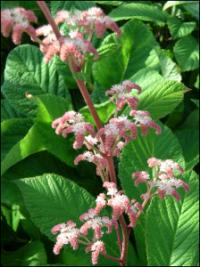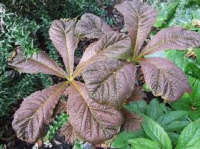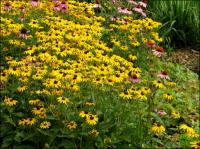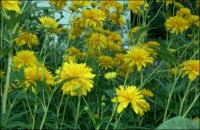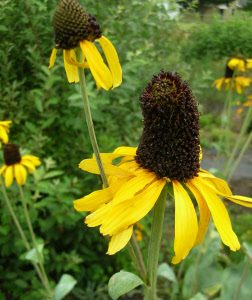Perennials & Biennials
Showing 393–400 of 511 results
-
Rheum palmatum var. tanguticum Ornamental rhubarb Z 4-8
Gigantic, jagged-edge, bronze-tinted turning green foliage with pink plumes reaching skyward atop tall stalks in early summer.
OUT OF STOCK
Gigantic, jagged-edge, bronze-tinted turning green foliage with pink plumes reaching skyward atop tall stalks in early summer.
Size: 8' x 6'
Care: Sun to part shade, moist well-drained fertile soil, mulch in spring
Native: valleys of Gansu, Qinghai, Shaanxi, Xizang, ChinaRhubarb carried from its native China to central Asia and then to Europe by caravans more than 2000 years ago. Both Dioscorides and Pliny mentioned the plant during the 1st century A.D. In 1300’s Marco Polo explained that merchants of China do not take beasts of burden into the mountains where rhubarb grows because “if eaten by them, has the effect of causing the hoofs of the animal to drop off.” This variety 1st described in 1874
-
Rodgersia aesculofolia Finger-leaf rodgersia Z 5-7
Showy, fragrant, pink-tinged, ivory flowers along stems rising up to 2’ over basal foliage. Come for the flowers and stay for the foliage - 12” wide bronze-tinted, crinkled, double-tooth edged, palmate shaped of seven leaflets radiate like spokes of a wheel.
Showy, fragrant, pink-tinged, ivory flowers along stems rising up to 2’ over basal foliage. Come for the flowers and stay for the foliage – 12” wide bronze-tinted, crinkled, double-tooth edged, palmate shaped of seven leaflets radiate like spokes of a wheel.
Size: 3-5’ x3-5’
Care: sun to part shade in moist well-drained to wet soil
Native: northern ChinaFirst collected in Sichuan province, China by Siberian Grigorii Potanin (1835-1920) in 1884. Trudy Imp. S.-Peterburgsk. Bot. Sada vol 13 p. 96 (1893). For his political activity as a Siberian separatist Potanin spent years in Russian prison. An accomplished geographer and naturalist he explored much of Kazakhstan and Mongolia and parts of China. In 1879-1880 he explored northern Mongolia collecting many plants and animal specimens.
-
Rodgersia pinnata Rodger’s flower Z 5-8
July-August pink, sometimes white, panicles top crinkly, lance-shaped, palmate leaves
July-August pink, sometimes white, panicles top crinkly, lance-shaped, palmate leaves
Size: 3' x 30"
Care: shade in moist soil
Native: China
Wildlife Value: deer resistant.
Awards: England’s Royal Horticultural Society Award of Merit & Elisabeth Carey Miller Botanical Garden Great Plant PicksRodgersia named for American Admiral John Rodgers (1812-1882) who led an expedition in the Pacific in 1852 during which the 1st species of this genus was discovered. This species introduced from its native China by Ernest “Chinese” Wilson (1876-1930) by 1910.
-
Rodgersia podophylla Bronze-leaf rodgersia In China: gui deng qing Z 5-8
Blooming, creamy white panicles in summer, atop five leaflets, shield-shaped, jagged incisions at the ends forming a palmate shape.
Blooming, creamy white panicles in summer, atop five leaflets, shield-shaped, jagged incisions at the ends forming a palmate shape.
Size: 3-5’ x 3-4’ and slowly spreading by rhizomes.
Care: part shade in moist to moist well-drained acidic soil
Native: woodland & stream edges in Japan, China & Korea
Awards: Elisabeth Carey Miller Botanic Garden, Great Plant Pick Award.Rodgersia named for American Admiral John Rodgers (1812-1882) who led an expedition in the Pacific in 1852 during which this plant was collected. 1st mentioned in literature 1858. Named by Harvard botanist Asa Gray. Species name from the Greek for foot (podos) and leaf (phyllon).
-
Rudbeckia fulgida Black eyed susan Z 4-9
The classic Black-eyed susan, 3" wide yellow daisies with a dark center from July-October
The classic Black-eyed susan, 3″ wide yellow daisies with a dark center from July – October
Size: 30" x 18"
Care: full sun to part shade in moist well-drained to well-drained soil
Native: Southeastern U.S.
Wildlife Value: A great number of bees, flies and beetles collect pollen or drink nectar from this RudbeckiaThis species fulgida was introduced to England in 1760 and named in William Aition’s Hortus Kewensis, V. 3 p. 251 (1789). Cherokee ate the stems and leaves and also used this species to remedy earaches, sores, flux, venereal disease, snakebites, dropsy, and swelling. Iroquois healed the heart and rid children of worms with this, Potawatomi make a brown dye with this.
-
Rudbeckia laciniata ‘Herbstsonne’ Rudbeckia nitida ‘Herbstsonne’ syn. Rudbeckia ‘Autumn Sun’ Z 5-10
Exceptionally large & drooping petals, with a tall, central cone of green, blooms July to September.
OUT OF STOCK
Exceptionally large & drooping petals, with a tall, central cone of green, blooms July to September.
Size: 4-7’ x 2-3’
Care: sun to part shade in moist well-drained soil
Wildlife Value: provides butterfly nectar and seeds food for birds
Awards: Royal Horticultural Society Award of Garden MeritIt’s “an old selection.”
-
Rudbeckia laciniata var. hortensia Golden Glow Z 3-9
"Rich, yellow double flowers borne in autumn, excellent for cutting," Sanders 1913. July-August blooms on these imposing double daisies.
“Rich, yellow double flowers borne in autumn, excellent for cutting,” Sanders 1913. July-August blooms on these imposing double daisies.
LIMITED QUANTITES AVAILABLE, LIMIT OF 1 PER CUSTOMER PLEASE
Size: 5-7' x 12" and spreading
Care: full sun, moist well-drained to well-drained soil, drought tolerant & immune to Walnut toxins.Serendipitous discovery in a group of seedlings in 1894. Said to be “the most popular hardy perennial introduced during the last 25 years,” April, 1905, The Garden magazine. Recommended by Gertrude Jekyll in 1908. Beth in New Mexico advised that her alpaca named Ricardo finds them delicious.
-
Rudbeckia maxima Great coneflower Z 4-9
Magnificent wildflower with huge paddle-shaped leaves of blue-grey-green and tall stalks of finch-gold petals
Magnificent wildflower with huge paddle-shaped leaves of blue-grey-green and tall stalks of finch-gold petals encircling central cones 4-5″ tall.
Size: 5-6' x 2'
Care: Sun in moist to moist well-drained soil
Native: OK, AK, TX & LA
Wildlife Value: Nectar source for larvae of painted Lady butterfly & for large Wood nymph butterfly.Rudbeckia was named by Linnaeus for his University of Upsala professor, Olaf Rudbeck. Rudbeck made the surprising claim “that the Paradise of Scripture was situated somewhere in Sweden.” C.F. Leyel. This species collected by Englishman Thomas Nuttall (1786-1859) in Oklahoma Territory near the Red River in 1816. Nuttall searched much of the No. American continent from New England west to Oregon, the South, Midwest, the Plains, S.E., California & Hawaii, finding thousands of new plants.



